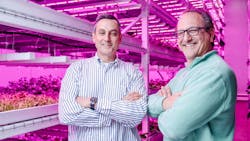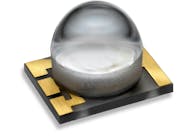Indoor vertical farming- more growth, less footprint: Green Sense Farms, Portage, Indiana
The United Nations predicts that the world’s urban population will increase by 2.5 billion people within the next 35 years. That means that farmers will need to increase food production by up to 70%. However, 80% of the world’s land that is suitable for growing food is already in use. In addition to the challenges posed by rapidly growing urban populations and the need to grow more food, farmers also have to contend with an increasing frequency of extreme weather patterns across the globe, which regularly devastate crops. Also, each year more pesticide-resistant organisms evolve, which also reduce crop yields.
Challenge
Green Sense Farms is the creation of Founding Farmers Robert Colangelo and Carl Wenz who are entrepreneurs and innovators. They wanted to show that fresh produce could be grown and distributed profitably all-year-round within the Midwestern United States, providing a consistently fresh supply of food for consumers, and dramatically reducing the emissions associated with long-haul food transportation. Green Sense Farms is located in Portage, Indiana, only 40 miles from downtown Chicago. The operation is one of the world’s largest indoor commercial farms using LED grow lights. It grows micro greens, baby greens, culinary herbs and lettuces 24 hours a day, 365 days a year – and can produce around 1.5 million tons of produce annually.
Solution
Green Sense Farms leases a 30,000-square foot warehouse in an industrial park with excellent access to the Interstate highway system. The farm is centrally located and can serve a 5-state Midwestern region. It has built two climate-controlled grow rooms. Each grow room is equipped with seven 12-meter tall grow towers, containing 60 tubs of growing space in each tower. In all, 7,000 Philips GreenPower LED production modules illuminate each tub.
Philips GreenPower LED production modules emit less heat than traditional fluorescent lights, so they can be placed closer to the plants, allowing for more levels to be stacked. The cool burning lights require less climate control and use less energy. For Green Sense Farms this resulted in a cost savings and increased production compared with traditional fluorescent-illuminated indoor growing environments. In combination with the 10-level vertical stacking towers, each square meter of grow room space produces more crops than traditional greenhouse farming.
By growing crops vertically, we are able to achieve a higher yield, with a smaller footprint, with little impact on the environment.” Robert Colangelo, Founding Farmer/President, Green Sense Farms
Green Sense Farms worked with Philips and to identify the optimum light recipe for the leafy greens grown at the farm. The light recipe includes only those specific wavelengths that each particular plant needs to optimize growth. This ensures that the LED solution delivers the ideal light needed for growth, resulting in a high-quality crop that consistently grows in the least amount of time - between 15-40 days based on crop type.
With a footprint of just 30,000-square feet, we can grow fresh produce that can be distributed to a customer base of 20 million people who live within 100 miles of the farm.” Carl Wenz, Founding Farmer, CFO
Benefits
• Affordable, fresh food all-year-round for customers in the Midwest
• More efficient use of land, water and energy
• Free of pesticides, herbicides, preservatives and GMO seeds
• Dramatically fewer emissions caused by the transportation of food
Green Sense Farms is a leader in indoor controlled environment agriculture. As the global population exceeds 7 billion people, this sustainable method of farming requires a small footprint to produce high volumes of quality leafy greens year-round to local consumers while conserving energy and water. The future of farming is now.









